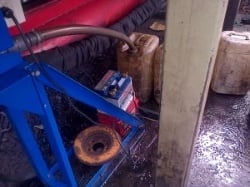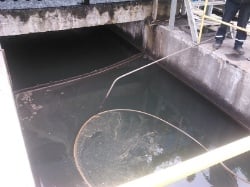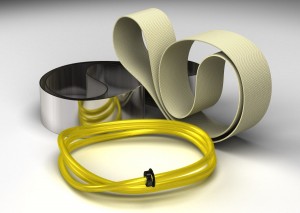Choosing an oil skimmer best suited for your application will maximize oil removal while minimizing capital outlay and oil skimmer operating costs. There are 5 crucial steps that need to be considered when purchasing a skimmer for your application. Skipping one or any of these concepts can result in having zero success in removing oil from your waste water. So let’s keep that from happening and go over these 5 simple steps!

The first step in choosing an oil skimmer is to define the operating conditions in which the skimmer will be operating. All oil skimmers have a moving medium, and possibly other parts, immersed in the liquid. The performance and life of the pick-up medium, wiper blades, pulleys, etc. are affected by different conditions. These conditions include temperatures in and out of the liquid, pH of the solution, and the presence of solvents or other reactive chemicals.
Hazardous Materials:
Applications involving flammable materials or explosive vapors require the use of explosion proof or air driven motors and controls.
Temperature/Viscosity:
All oil skimmers require floating oil to be in a liquid, free-flowing state. If the oil congeals or solidifies at ambient temperatures, the tank and/or oil skimmer will require heaters to maintain fluid flow. This is especially true at temperatures low enough to freeze water. A heater option is a must if an oil skimmer is to be used outdoors in freezing temperatures.
The second step in selecting an oil skimmer is to know what you need or expect your removal capacity to be. Capacity should be based on the maximum amount of oil to be removed within the shortest available time. For instance, total oil influx may be 200 gallons in a 24 hour period, which averages about 8.3 gallons per hour. But if most of it comes during a single eight hour plant shift, you will probably need a removal rate that is three times as high, especially if you are trying to prevent an unwanted discharge of contaminated water to a sewer system. As a rule-of-thumb, specify approximately twice the maximum capacity you anticipate needing for normal conditions.
Rating:
Oil skimmers usually have an oil removal rate expressed in gallons per hour. The rate varies with oil viscosity, so Abanaki rates skimmers using SAE 30 weight motor oil at 65°F (18°C). When specifying removal capacity, it is better to err on the high side to allow for peaks in the oil influx.
Water Content:
All oil skimmers pick up some water with the oil they remove. Some designs, particularly suction skimmers, pick up more water than others. High water content increases oil recycling and disposal costs. Generally, the ratio of water-to-oil decreases with thicker films of floating oil and slower moving pick-up media. An Oil Concentrator® or decanter installed at the oil skimmer discharge port provides secondary oil/ water separation that can reduce water content to nearly zero.
Residual Oil:
An oil skimmer continues to remove oils as long as they are present. Depending on oil influx rate and the oil skimmer's removal rate, residual oil in the water may be as low as a few parts per million. When residual oil reaches this level and further reduction is required, it may be more practical to use a secondary removal method following skimming, such as membrane filtration.
Portability:
Oil skimmer portability is a plus in some applications. For example, in plants, mobile equipment service shops, and at remediation sites, a portable oil skimmer can sometimes service multiple machines, sumps, or wells.
Understanding your tank or sump’s characteristics is the third thing you will want to consider when choosing an oil skimmer for your process. The location, shape, and capacity of a tank or water impoundment are major factors in choosing the right oil skimmer. Also consider fluctuations in water level, turbulence and possible emulsions. Although oil skimmers do not cause emulsions, they can have trouble removing certain types.

Size/Design:
Oil and water can emulsify when subjected to turbulence and other mechanical agitation. Avoid this by having water return to the tank below the liquid surface at as low a velocity as practical. Make sure your tank or sump provides quiet areas, weirs, and sufficient volume to allow adequate time for oil/water separation.
Shape:
Tanks without nooks and crannies for oil to accumulate in are best. If you have an irregular shape, put the oil skimmer where the largest amount of oil accumulates. Consider a means of directing oil towards the oil skimmer such as a floating boom or baffle plate.
Location/Installation:
The physical location and characteristics of the tank and collection container are important. Does skimmed oil need tom be pumped from the oil skimmer to the container? Will oil skimmer access for periodic maintenance be a problem? How much mounting space is available? Are tank or container modifications required? Cheap oil skimming systems quickly lose appeal when costs for additional components, increased maintenance and expensive tank modifications are involved.
The next step is determining which belt, tube, or disk to select for your skimmer. Obviously, you need the proper media on your skimmer in order to ensure the best results. And if you think all belt types or materials operate the same or that simply picking the cheapest option will suffice, you’re wrong and you’d be setting yourself up for failure. You can have a skimmer that is top of the line, but if you have the wrong belt, tube, or disc material on it then it won’t matter how great of a skimmer you have in that tank. Your results will be less than stellar.
Belt performance and durability depends on the nature of the liquid, its chemical composition, temperature,  etc. For instance, high temperature increases a belt’s sensitivity to pH levels. So if the temperature of your application is above 160°F and you’re thinking of using a Polymer belt, then I would suggest you think again. It’s always best to share your application’s temp and pH levels with your sales person so they can select the right belt material for you.
etc. For instance, high temperature increases a belt’s sensitivity to pH levels. So if the temperature of your application is above 160°F and you’re thinking of using a Polymer belt, then I would suggest you think again. It’s always best to share your application’s temp and pH levels with your sales person so they can select the right belt material for you.
In the same vein, choosing the right wiper blade is important, too. You’ll want something that can endure the temperatures and pH levels of your application so they don’t melt or warp or completely break during operation.
Oil Skimmer Belt and Tube Length: Removal capacity is not affected by length. Choose a length that: assures contact with the liquid at its lowest level; allows easy mounting of the oil skimmer where oil discharge is convenient; and has good access for routine service. It is important to find a company that has the ability to supply oil skimmers with long belts, and lift skimmed oil well over 100 feet with no loss in capacity or efficiency. Find a company that will work with the needs of your application.
In regards to Disk Diameter: The disk must always be touching the fluid. Size the diameter accordingly.

See how this stainless steel belt easily picks up hydrocarbons
In the same vein, choosing the right wiper blade is important, too. You’ll want something that can endure the temperatures and pH levels of your application so they don’t melt or warp or completely break during operation.
Accessories are a skimmer’s best friend! Or so they say. The fifth step in choosing an oil skimmer is determining if your application requires any additional add-ons, such as specific motor types or additional skimmer equipment. Most oil skimmers are designed with standard, industrially rated, continuous duty motors and fully enclosed speed reducing drives. Most of these oil skimmers can be specified with the following motor options:
- Any standard or exceptional electrical requirement
- Explosion proof
- Drip proof
- Tropicalized
- Dirty duty
- Food service
- Wash down duty
- DC motors
- ATEX/European motors
Oil skimmer accessories make it easy to customize your oil skimming system for quick installation and optimal performance. These are the most commonly requested items. More specialized accessories are typically available on request.
-Solar Oil Skimming System
A solar oil skimming option is ideal for locations that do not have access or have limited access to electricity. A 12V DC motor runs off a deep cycle battery that is recharged by the solar panel. Various 12V accessories are available as well.
This option is for applications in which the oil storage tank is far from the point of oil removal or for below ground applications. This turnkey system consists of a small collection tank, a pump, small control panel and three float switches. The oil that the oil skimmer picks up is deposited to the collection tank. When the collection tank is full, the middle float switch signals the pump to turn on. The oil is then pumped to your storage tank or facility for permanent removal or storage.
-Controls/Accessories
Companies may offer a float switch and warning light combination to monitor fluid level in the skimmed oil collection drum, which helps prevent overflow. Other electrical options include timer, heater, and control panel. There are also poly shelters and discreet secure enclosures as well as a variety of mounting options for the oil skimmer.
-Concentrators
Oil Concentrators provide a secondary separation step after oil skimming to virtually eliminate water from skimmed product. Units are available for easy installation on most oil skimmers.
Choosing the right oil skimmer doesn't have to be a disastorous process, but things can go sideways quickly if you don't address certain aspects of your application. As always, make sure you are dealing with a reputable vendor. Companies that really know and understand how oil skimmers work will ask you all about the content above, if they don't, RUN! Bottom line: know your application, choose a vendor you trust, and your oil skimming operation will be smooth sailing.



